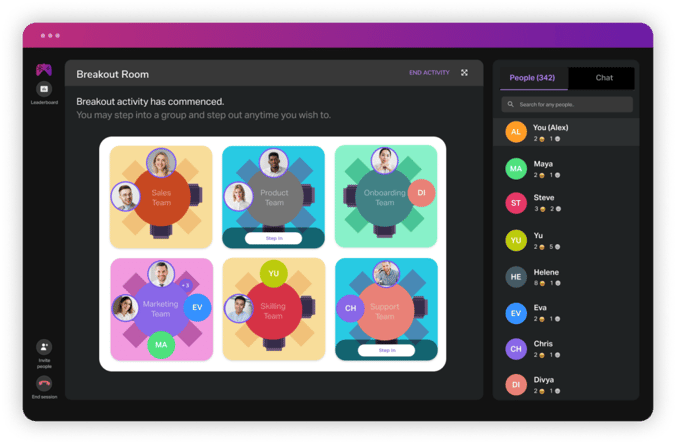Despite the fact that 94% of employees are interested in career development, most L&D courses have poor enrollment and completion rates. The primary reason for this is that employees are not engaged with traditional corporate learning programs.
Fortunately, gamification has emerged as a useful tool to make employee training more effective. Here we will explore the benefits of leveraging game-based learning, and provide eight best practices for effectively implementing gamification techniques in your corporate training.
What is Gamification?
Gamification is the process of integrating game mechanics into non-game areas, such as employee training, to increase engagement and make learning more enjoyable. By adding an element of fun, gamified learning can help boost learner engagement and motivation.
In fact, 83% of employees who undergo gamified training report being more motivated at work.
Top 5 Advantages of Gamification in Employee Learning
Gamification provides several benefits, beyond just increasing user engagement. It can accelerate learning, normalize feedback, and build social connections.

All of these benefits lead to better knowledge retention and improved learning outcomes for your employees.
1) Accelerate employee learning
One of the key benefits of gamification is accelerated learning. When employees feel rewarded for their learning efforts, they are eager to continue to learn and grow. By incorporating game mechanics such as points, badges, and leaderboards, employees can track their progress and compete in a friendly environment. This not only makes learning more engaging but also increases the likelihood of completion.

2) Improve knowledge retention
Gamification makes the learning process relevant and interactive. By incorporating real-life scenarios into an interactive training program, employees can see how the training applies to their work and how they can apply the knowledge gained from the training to real-life situations. This increases the likelihood that important knowledge will be retained.
3) Normalize feedback
In games, players are accustomed to receiving immediate feedback on their performance. By incorporating this same feedback loop into the game-based learning process, your employees will no longer see feedback as negative. They will accept and learn from it, which improves performance over time.
4) Build social connections in the workplace
When your employees can compete in a friendly environment, it fosters a sense of camaraderie and teamwork. This is particularly helpful for remote teams, where social interaction can be limited. By creating opportunities for collaboration and positive interactions, gamified learning strengthens team relationships improves overall performance, and will bring you closer to the organization’s business goals.

5) Increase learning ROI
Gamification increases your learning ROI by improving the effectiveness of training programs. Your employees will be more engaged with the gaming element experience and retain knowledge that they directly apply to their work. Incorporating gamified learning elements, such as interactive simulations and scenarios, provides a more hands-on user experience that leads to better job performance, increased productivity, and improved business outcomes.
6 Best Practices for Gamification in Employee Training
Gamification has proven to be an effective way to increase user engagement and motivation in employee learning. However, effective implementation of gamified learning requires a strategic approach and careful consideration of best practices.
Here are 6 best practices to ensure you are effectively leveraging gamification for employee learning.

1) Set clear learning goals
Before gamifying your employee learning program, you need to establish clear learning objectives. Determine what skills and knowledge you want your learners to acquire, and design your learning strategy to support those objectives.
2) Choose the right gamified learning management system
To gamify L&D, you must incorporate a Learning Experience Platform (LXP) with advanced gamification features. The LXP you choose should have the following elements:
-
-
Quizzes and polls
-
Breakout rooms for team collaboration or competitions
-
Leaderboards
-
Badges to highlight accomplishments
-

3) Make it relevant and contextual
The learning elements you use must be relevant and contextual to your employees’ work. Align them with the specific tasks and responsibilities of your employees to increase the effectiveness of your gamification strategy.
4) Provide immediate feedback
As we mentioned, feedback is an essential component of gamification. Make sure that your employees receive immediate feedback on their progress, achievements, and areas for improvement. This will help them stay engaged and motivated.
5) Reward meaningful learning achievements
Reward your employees for meaningful achievements, such as completing a difficult task or mastering a new skill. This will reinforce their learning and motivate them to continue improving.
6) Continuously evaluate and improve
Continuously evaluate and improve your gamification program to ensure that it is effective and engaging. Gather feedback from your employees and adjust your approach accordingly to optimize their learning and user experience.
Conclusion
Employee training and development are essential components of any successful organization. However, traditional corporate training programs often fail to engage employees, resulting in poor enrollment and completion rates. Fortunately, by incorporating game mechanics you can accelerate learning platform while driving employee engagement and motivation.








